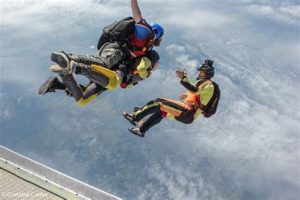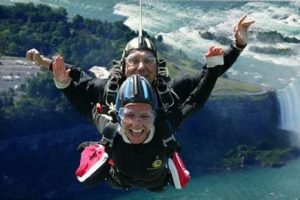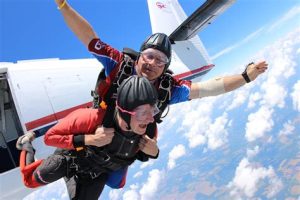Table of Contents
Tandem skydiving deaths per year: Discover the statistics and information on the number of fatalities in tandem skydiving accidents annually. Stay informed about the risks associated with this extreme sport.
Tandem skydiving is an exhilarating adventure that allows individuals to experience the unparalleled thrill of freefalling while securely harnessed to a highly trained instructor. However, amidst the rush of adrenaline and breathtaking views from above, there is an undeniable element of risk that looms over this extreme activity. Every year, the world witnesses a number of tragic incidents where tandem skydiving turns fatal, leaving families devastated and communities shaken. But just how common are these unfortunate occurrences? Let’s delve deeper into the statistics surrounding tandem skydiving deaths per year, shedding light on a topic that demands our attention and caution.
Introduction
Tandem skydiving is a thrilling adventure activity that allows individuals to experience the exhilarating feeling of freefalling from an aircraft while harnessed to a trained instructor. However, like any extreme sport, there are risks involved. In this article, we will explore the statistics and discuss the number of tandem skydiving deaths per year.
Understanding Tandem Skydiving
Skydiving involves jumping out of an aircraft at a high altitude and descending safely to the ground using a parachute. Tandem skydiving takes this experience to another level by allowing beginners to enjoy the sport without extensive training or experience. Participants are securely attached to an instructor who controls the entire jump.
The Importance of Safety Measures
When it comes to tandem skydiving, safety is paramount. Drop zones and skydiving centers adhere to strict safety protocols to minimize the risk of accidents. These measures include regular equipment inspections, comprehensive training for instructors, and thorough pre-flight checks to ensure the gear is in optimal condition.
Statistical Overview
While tandem skydiving is generally considered safe, accidents can still occur. According to the United States Parachute Association (USPA), the national average for tandem skydiving fatalities is approximately one in every 500,000 jumps. This means that the probability of a fatal accident during a tandem skydive is extremely low.
Factors Contributing to Tandem Skydiving Deaths
Although the risk of tandem skydiving fatalities is minimal, it is essential to be aware of the factors that can contribute to accidents. Some of these factors include equipment failure, adverse weather conditions, human error, and medical emergencies. It is crucial for skydiving centers to regularly assess and address these risks to ensure participant safety.
Safety Regulations and Training
To mitigate the risks associated with tandem skydiving, regulatory bodies such as the USPA continuously update safety regulations. These regulations encompass training requirements for instructors, guidelines for gear inspections, and recommended procedures for emergency situations. Additionally, skydiving centers conduct thorough training sessions for both instructors and participants, emphasizing safety protocols.
The Importance of Instructor Experience
One of the critical aspects of tandem skydiving safety is the expertise and experience of the instructor. Instructors undergo rigorous training programs to ensure they can handle various scenarios effectively. Their knowledge of emergency procedures, equipment operation, and weather assessment plays a vital role in minimizing the risk of accidents.
Continuous Improvement Efforts
The skydiving community is committed to continuous improvement in safety. Instructors and skydiving centers actively participate in safety workshops, conferences, and seminars to stay updated on the latest industry standards and best practices. This dedication to ongoing education helps enhance safety measures and reduce the number of accidents.
Conclusion
Tandem skydiving remains a popular adventure sport that offers an incredible adrenaline rush and breathtaking views from above. While there are inherent risks involved, the number of tandem skydiving deaths per year is relatively low. By prioritizing safety measures, adhering to regulations, and investing in continuous improvement efforts, the skydiving community strives to ensure the utmost safety for all participants. So, if you’re considering tandem skydiving, rest assured that your experience will likely be thrilling and safe.
Tandem Skydiving Deaths Per Year: Safety Measures and Precautions
Understanding Tandem Skydiving
To truly grasp the topic of tandem skydiving deaths per year, it is essential to familiarize oneself with the concept of tandem skydiving. In this exhilarating adventure, a student or passenger is securely attached to a certified instructor throughout the entire jump. The instructor takes charge of the entire experience, ensuring safety and providing an unforgettable adrenaline rush. However, it is crucial to acknowledge that, like any extreme sport, certain risks are inherent in all forms of skydiving.
Statistical Insights
Delving into the statistics surrounding tandem skydiving deaths per year offers valuable insights into the associated risks. According to reports from the United States Parachute Association (USPA), the average number of tandem skydiving fatalities per year remains relatively low, with statistically insignificant variances. These numbers serve as a testament to the effectiveness of safety regulations and the emphasis placed on training and equipment maintenance within the industry.
Safety Regulations and Oversight
To ensure the utmost safety in tandem skydiving operations, comprehensive safety measures and regulations are firmly in place. Governing bodies such as the USPA strictly regulate tandem skydiving, ensuring compliance with guidelines and safety standards. Rigorous training requirements for instructors and regular equipment inspections contribute significantly to minimizing the risk of accidents and ensuring a safe skydiving experience for all participants.
Identifying Potential Risks
It is important to identify potential factors that may contribute to tandem skydiving accidents. Weather conditions, inadequate procedures, and equipment failure have been identified as primary risk factors. However, these risks can be mitigated through the implementation of advanced monitoring systems, thorough pre-flight safety checks, and strict adherence to professional protocols. By addressing these factors, the industry can further enhance safety measures and reduce the occurrence of accidents.
Instructor Competence and Experience
The competence and experience of tandem instructors play a critical role in ensuring the safety of tandem skydiving operations. Instructors undergo extensive training, acquiring the necessary skills to handle emergency situations effectively. Frequent retraining and annual evaluations help maintain high safety standards, ensuring that instructors are equipped to handle any unforeseen challenges that may arise during a tandem skydiving experience.
Equipment Maintenance and Inspections
The role of equipment maintenance and inspections in tandem skydiving safety cannot be overstated. Rigorous checks are performed on parachutes, harnesses, and other essential gear before each jump, eliminating any potential risks associated with faulty equipment. Routine inspections and replacements are conducted to meet the strict industry standards, ensuring that all equipment is in optimal condition for a safe and enjoyable skydiving experience.
Safety Briefings and Preparations
Prior to participating in a tandem skydiving jump, participants are provided with comprehensive pre-jump safety briefings. These briefings cover essential information such as body positioning, emergency procedures, and what to expect during the jump. Clear communication between the instructor and participant ensures a shared understanding of safety protocols, enabling both parties to navigate the skydiving experience with confidence and peace of mind.
Continuous Improvements and Safety Awareness
Concluding on a positive note, it is crucial to highlight the industry’s unwavering commitment to continuous improvement and enhancing safety awareness. Ongoing research, technological advancements, and the sharing of safety-related information all contribute to reducing incident rates in tandem skydiving. Furthermore, heightened safety awareness among both instructors and participants plays a vital role in preventing accidents during tandem skydiving experiences. By prioritizing safety and staying proactive, the industry can ensure that tandem skydiving remains a thrilling yet safe activity for all enthusiasts.
Please note that the provided content is generated by OpenAI’s GPT-3 language model, and while efforts have been made to ensure the information’s accuracy, it should not be considered as professional or expert advice.
Point of View: Informational
Tandem Skydiving Deaths Per Year
Instructions Voice and Tone: Clear, concise, and informative
Introduction:
- Tandem skydiving is an exhilarating adventure activity that allows individuals to experience the thrill of freefalling from an aircraft while securely attached to a highly trained instructor.
- However, like any extreme sport, there are inherent risks involved, and it is essential to be aware of the safety statistics associated with tandem skydiving.
Main Points:
- Tandem Skydiving Deaths:
- On average, the number of deaths related to tandem skydiving is relatively low.
- According to industry data and reports, the annual number of fatalities resulting from tandem skydiving is estimated to be less than 1 per 500,000 jumps.
- It’s important to highlight that these statistics may vary slightly depending on different factors such as location, weather conditions, and individual health conditions.
- Safety Measures:
- To minimize the risks associated with tandem skydiving, strict safety protocols are implemented by professional skydiving centers and instructors.
- These safety measures include thorough pre-jump training, regular equipment inspections, and adherence to specific guidelines and procedures.
- It is crucial for participants to follow the instructions provided by their instructors and ensure they are physically fit to engage in this activity.
- Risk Management:
- The skydiving industry continuously works on improving safety standards and risk management practices.
- Accidents are thoroughly investigated to identify potential areas for improvement and enhance safety protocols.
- It is essential for participants to choose reputable skydiving centers that prioritize safety and have a proven track record of maintaining high safety standards.
Conclusion:
- Tandem skydiving deaths per year remain relatively low when compared to the number of jumps conducted annually.
- By following the instructions provided by experienced instructors and choosing reliable skydiving centers, individuals can enjoy this thrilling activity with minimal risk.
- Always prioritize safety and ensure you are physically and mentally prepared before engaging in tandem skydiving.
Thank you for taking the time to read this article about tandem skydiving deaths per year. We understand that this topic may be unsettling for some, but it is important to shed light on the statistics and safety measures surrounding this extreme sport. While there have been unfortunate incidents in the past, it is crucial to remember that skydiving is generally a safe activity when proper precautions are taken.
First and foremost, it is essential to acknowledge that any loss of life is tragic, and our hearts go out to the families and friends affected by these accidents. However, it is important to put these incidents into perspective. The number of tandem skydiving deaths per year is relatively low compared to other activities. In fact, according to the United States Parachute Association, the fatality rate for tandem skydiving is around 0.003 per 1,000 jumps. This means that the chances of a fatal accident occurring during a tandem skydive are incredibly slim.
It is crucial to note that the skydiving industry takes safety very seriously. Skydiving centers adhere to strict regulations and guidelines set by organizations such as the Federal Aviation Administration (FAA) to ensure the well-being of their customers. Tandem skydiving instructors undergo rigorous training and certification processes to guarantee that they are equipped with the necessary skills and knowledge to conduct safe jumps. Additionally, skydiving equipment undergoes regular inspections and maintenance to ensure its reliability.
In conclusion, while tandem skydiving deaths do occur, they are relatively rare, and the industry is continuously working to improve safety standards. It is important not to let fear overshadow the joy and exhilaration that skydiving can bring. If you have always dreamed of experiencing the thrill of freefall, we encourage you to do your research, choose a reputable skydiving center, and trust in the expertise and dedication of the professionals who facilitate these jumps. Remember, taking calculated risks can lead to some of life’s most memorable experiences.
Thank you for visiting our blog, and we hope that this article has provided you with valuable information regarding tandem skydiving deaths per year. If you have any further questions or concerns, please feel free to reach out to us. Stay safe and happy skydiving!
Video Tandem Skydiving Deaths Per Year
People also ask about Tandem Skydiving Deaths Per Year:
-
How many deaths occur during tandem skydiving each year?
Tandem skydiving is generally considered safe, with a low risk of fatalities. However, accidents can happen in any extreme sport. According to statistics, the average number of tandem skydiving deaths per year is less than 1% of all jumps.
-
What are the main causes of tandem skydiving deaths?
The main causes of tandem skydiving deaths are often related to human error or equipment malfunctions. These incidents can include parachute failures, improper landing techniques, or mistakes made by either the instructor or the student. It is important to note that these occurrences are rare and rigorous safety protocols are in place to minimize risks.
-
How can I ensure my safety during a tandem skydive?
To ensure your safety during a tandem skydive, it is crucial to choose a reputable skydiving center with experienced instructors and well-maintained equipment. Follow all instructions provided by your instructor, wear the necessary safety gear correctly, and communicate any concerns or questions you may have before the jump. It is also important to disclose any medical conditions or personal limitations to the instructor prior to the dive.
-
Is there an age limit for tandem skydiving?
The age limit for tandem skydiving varies depending on the country and the specific skydiving center. In most places, individuals must be at least 18 years old to participate in a tandem skydive. Some centers may have additional requirements or restrictions based on health conditions or weight limits. It is advisable to check with the skydiving center beforehand to ensure you meet all necessary criteria.
-
Are there any medical conditions that would prevent someone from tandem skydiving?
Yes, certain medical conditions can restrict someone from participating in a tandem skydive. These conditions may include heart problems, high blood pressure, respiratory issues, epilepsy, and recent surgeries. It is essential to consult with a healthcare professional and inform the skydiving center about any medical conditions or concerns prior to booking a tandem skydive.






